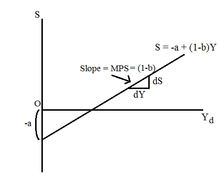The marginal propensity to save (MPS) is the fraction of an increase in income that is not spent and instead used for saving. It is the slope of the line plotting saving against income. For example, if a household earns one extra dollar, and the marginal propensity to save is 0.35, then of that dollar, the household will spend 65 cents and save 35 cents. Likewise, it is the fractional decrease in saving that results from a decrease in income.
The MPS plays a central role in Keynesian economics as it quantifies the saving-income relation, which is the flip side of the consumption-income relation, and according to Keynes it reflects the fundamental psychological law. The marginal propensity to save is also a key variable in determining the value of the multiplier.
Calculation
MPS can be calculated as the change in savings divided by the change in income.
Or mathematically, the marginal propensity to save (MPS) function is expressed as the derivative of the savings (S) function with respect to disposable income (Y).
- where, dS=Change in Savings and dY=Change in income.
Notes
- marginal propensity to save is opposite of marginal propensity to consume;
- mps oscillates between 0 and 1;
- mps can never be negative.
Slope of saving line

Multiplier effect
Mathematical implication
The end result is a magnified, multiplied change in aggregate production initially triggered by the change in investment, but amplified by the change in consumption i.e. the initial investment multiplied by the consumption coefficient (Marginal Propensity to consume).
The MPS enters into the process because it indicates the division of extra income between consumption and saving. It determines how much saving is induced with each change in production and income, and thus how much consumption is induced. If the MPS is smaller, then the multiplier process is also greater as less saving is induced, but more consumption is induced, with each round of activity.
Thus, in this highly simplified model, total magnified change in production due to change in an autonomous variable by $1
=
Measuring the multiplier
See also
- Marginal propensity to consume
- Marginal propensity to import
- Average propensity to consume
- Average propensity to save
- Fundamental psychological law
Notes
- Blanchard, O. (2006). Macroeconomics. (Fourth ed., p. 59). Pearson Education Inc.
- Robert Marks, "Macroeconomics for manager", Lecture Series, March 1997, Australian Graduate School of Management, University of New South Wales
- "Induced Savings", AmosWEB LLC, Economic WEB*pedia,2010-2011. Web.
- "AmosWEB is Economics: Encyclonomic WEB*pedia".
External links
- "Marginal propensity to save" Encyclopædia Britannica. Encyclopædia Britannica Online. Encyclopædia Britannica Inc., 2011. Web.
- "Marginal Propensity to save", AmosWEB LLC, Economic WEB*pedia,2010-2011. Web.

 where, dS=Change in Savings and dY=Change in income.
where, dS=Change in Savings and dY=Change in income.